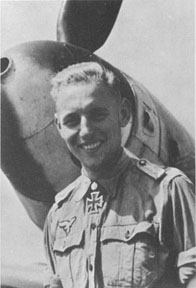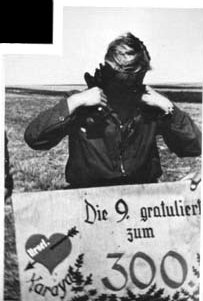 Major Erich Hartmann
Major Erich Hartmann Major Erich Hartmann
Major Erich Hartmann
"Of all my
accomplishments I may have achieved during the war, I am proudest of the fact that I never
lost a wingman. It was my view that no kill was worth the life of a
wingman. . . . Pilots in my unit who lost wingmen on this basis were prohibited from
leading a [section]. They were made to fly as wingman, instead." |
 For his extraordinary abilities in a black-nosed Messerschmitt
109, the Soviets dubbed Luftwaffe pilot Erich Hartmann Cherniye Chort or Black
Devil,(a name which was wildly at variance with his radio call-sign 'Karaya [Sweethart]
One') and placed a 10,000-ruble price on his head.
For his extraordinary abilities in a black-nosed Messerschmitt
109, the Soviets dubbed Luftwaffe pilot Erich Hartmann Cherniye Chort or Black
Devil,(a name which was wildly at variance with his radio call-sign 'Karaya [Sweethart]
One') and placed a 10,000-ruble price on his head.
Because he arrived at the Eastern Front looking far younger than his 20 years, Walter Krupinski (197 victories) nicknamed him Bubi, or "boy." Krupinski was a bar-room brawler type of pilot. Hartmann was coerced into becoming his Kacmarek and it was he who urged Hartmann to get in close before firing. Many years later after the war Hartmann described the abilities he had developed as a result of his training under Krupinski, Rossmann and others:
I never cared much for the dogfight. I would never dogfight with the Russians. Surprise was my tactic. Get the highest altitude and, if possible, come out of the sun...ninety percent of my attacks were surprise attacks. If I had one success, I took a coffee break and watched the area again. Finding [the enemy] depended purely on being where the action was concentrated on the ground and on visual look-out. Ground stations called us by radio the position of the enemy after a coordinated system on our maps. So we could search in the right direction and choose our best attack altitude. If I covered the sky, I preferred a full-power, sun attack from below, because you could spot the enemy very far away against a white cloudy sky. The pilot who sees the other pilot first already has half the victory. The second step of my tactic was the point of decision. That is, you see the enemy and decide whether to attack immediately, or wait for a better situation. or maneuver to make it more favorable, or not to attack at all. For example, if you have to attack the enemy against the sun, if you don't have enough altitude, if the enemy is flying in broken clouds, you keep your enemy in sight far enough so you can change your attack position in the sun or above the clouds, diving to sell your altitude for high speed. Then attack. It doesn't matter if you pick on the straggler or the guy out of formation. The most important thing is to destroy an enemy aircraft. Maneuver quickly and aggressively and shoot in close, as near as possible to ensure the hit and save rounds. I told my men, 'Only if the windshield is filled up, then pull the trigger.' Finally break or reverse. If you hit and run, think about survival. Immediately check six and reverse. Clear the area for potential attackers or pick a new point of re-entry and do it again, if you have the advantage. |
 By either
reckoning, Erich Hartmann, the top scoring fighter ace of the entire war, was an enigma.
Quiet and unassuming, he lacked the flamboyance of most fighter aces. Yet in only two and
a half years - between October 1942 and May 1945 - this modest hero accumulated a
record-breaking total of 352 victories, rose to command Gruppe No. 1 of the Luftwaffe's
most successful fighter wing, Jagdgeschwader 52, and earned one of Germany's most coveted
military medals: the Knight's Cross of the Iron Cross with Oak
Leaves, Swords and Diamonds.
By either
reckoning, Erich Hartmann, the top scoring fighter ace of the entire war, was an enigma.
Quiet and unassuming, he lacked the flamboyance of most fighter aces. Yet in only two and
a half years - between October 1942 and May 1945 - this modest hero accumulated a
record-breaking total of 352 victories, rose to command Gruppe No. 1 of the Luftwaffe's
most successful fighter wing, Jagdgeschwader 52, and earned one of Germany's most coveted
military medals: the Knight's Cross of the Iron Cross with Oak
Leaves, Swords and Diamonds.
Erich Hartmann's first success in combat was also very nearly his last!
On November 5, 1942, flying wingman in a Schwarm of four Me109s of JG-52, his flight had scrambled to intercept Russian Lagg-3s and IL-2 fighter-bombers bound for the Front. Splitting into two elements they dived steeply into attack, screaming in behind and below the enemy aircraft a few hundred feet off the deck.
Selecting one of the IL-2s, the rookie pilot closed at high speed, commencing firing with 20mm cannon from about two hundred feet. His first pass was unsuccessful but, undeterred, Hartmann zoomed up and dived over for a second run at the Russian machine. Holding his fire till the IL-2 filled his gun-sight, he drilled cannon shells into the oil-cooling system setting the enemy aircraft on fire.
Closing rapidly from behind, Hartmann's Me109 was showered with debris from the doomed Russian plane, causing an explosion in the young pilot's own aircraft, which immediately caught fire. Now at very low altitude, Hartmann had no alternative but to belly in. With great presence of mind he cut power, fuel and ignition switches as he crash-landed at high speed in a massive cloud of dirt and dust.
Though he lost his aircraft, Hartmann had made his first kill, the IL-2 crashing with a resounding explosion a few miles distant. Unhurt, the young future Ace was picked up and returned to base almost immediately by a German car. And thus a legend was born: It was the first of 352 air victories, that would make Hartmann the top scoring fighter pilot in history.
The secret of Hartman's success was summed up in his advice to young pilots, "Fly with your head, not your muscles." Rejecting the strenuous thrust-and-parry tactics of traditional dogfighting as a waste of time and ammunition, he preferred to take his victim by surprise: He would bore in close and attack at point-blank range. A less skilled pilot would have almost surely collided with his adversary, but Hartmann possessed an uncanny knack for breaking away at the last possible second. In 825 instances of aerial combat, he was never wounded, and his plane was forced down only 16 times - and often it had been hit by debris from aircraft Hartmann had destroyed.
Click on the (Bf) Me 109G below for more information. on Hartmann's plane
 The
Soviets soon learned to steer clear of him. Like the other planes in Jagdgeschwader 52's
Sweetheart Squadron, his Messerschmitt displayed a bleeding heart pierced by an arrow. But
unlike them it bore his own distinctive markings, a black tulip that Hartmann had painted
on its nose. Hartmann flew only 5 or 6 missions with his plane marked in this way.
Foregoing a chance to go after the 10,000-ruble prize, Soviet formations would scatter
when they spotted the tulip, and the Black Devil's tally leveled off accordingly. Only
after Hartmann had the design painted out - and regained his anonymity - did he go on to
achieve the score that set an all-time record. The call of 'Karaya One' was, of course,
well known to the Russians and they avoided him when possible making the feat all the more
remarkable.
The
Soviets soon learned to steer clear of him. Like the other planes in Jagdgeschwader 52's
Sweetheart Squadron, his Messerschmitt displayed a bleeding heart pierced by an arrow. But
unlike them it bore his own distinctive markings, a black tulip that Hartmann had painted
on its nose. Hartmann flew only 5 or 6 missions with his plane marked in this way.
Foregoing a chance to go after the 10,000-ruble prize, Soviet formations would scatter
when they spotted the tulip, and the Black Devil's tally leveled off accordingly. Only
after Hartmann had the design painted out - and regained his anonymity - did he go on to
achieve the score that set an all-time record. The call of 'Karaya One' was, of course,
well known to the Russians and they avoided him when possible making the feat all the more
remarkable.
Ace fighter pilots are often described as fearless. This is far from the truth. On his first encounter with an enemy aircraft Ernst Udet froze with fear and was unable to fight. Yet he went on to become the highest-scoring surviving German ace of the Great War, with 62 victories. As with Udet, so with Hartmann. Hartmann's first battle in October of 1942 was nothing short of a disaster. While flying as wing man to Edmund 'Paule' Rossmann (93 victories), he panicked and mistook Rossmann's plane for a Russian fighter and fled. He ended the sortie by belly-landing out of fuel far from his base. This humbling experience taught Hartmann to control his fear.
Hartmann knew he needed to improve his performance and for the next several months flew with some of his squadron's aces. He observed their flying and dog-fighting techniques and eventually developed his own. He trained himself to get within 150 ft of his opponent before firing. This was a hazardous maneuver but one which became his trademark.
After 91 sorties without a kill he made his first on November 9, 1942, and soon after his score began to climb. He had downed 90 planes by the end of August 1943 and by the end of October had scored 148 kills.
When he was awarded the Knight's Cross with Oak Leaves, Swords and Diamonds, Hitler advised him that he was too important to continue risking his life in combat and re-assigned him to a special fighter unit that was testing a new aircraft - the Me 262.
Hartmann believed that his services would be better utilized in defense of the retreating German Army and was able to pursuade Göring to cancel his orders. Göring complied and Hartmann soon became commander of Gruppe No. 1 of Jagdgeschwader 52. Leading his pilots in their final defense of the retreating German Army, he raised his total to 352 victories.
When Germany fell to the Allies on May 8, 1945, Hartmann surrendered to the Americans. He was later turned over to the Russians and spent 10˝ years in a Russian prison camp deep in the Soviet Union. Hartmann was offered a position in the East German air force, but refused and was sentenced to 25 years at hard labor. In 1955, West Germany effected his release and Hartmann came home to a hero's welcome. Three years later he was chosen to command the West German air forces first all-jet fighter wing. During this time Hartmann made several visits to the United States to learn to fly the latest U.S.-built jets. While there he shared with young American pilots the experience of his 825 air battles.
Erich Hartmann's score will never be matched. Few air forces have as many as 352 aircraft to lose, let alone to one man!
From The Epic of Flight/Time-Life Books and Mike Spick's Luftwaffe Fighter Aces